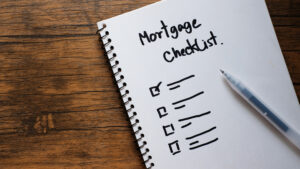


Buying a home is one of the biggest financial decisions you’ll ever make. The mortgage process can feel complex at first, but breaking it down into clear steps makes it much easier to manage.
This checklist walks you through each stage, from pre-approval to closing day. Whether you’re buying your first home or moving into a new one, being prepared can speed things up and help you avoid costly mistakes. With the right approach, you’ll be better positioned to secure a home that fits your needs and your budget.
Understanding Your Budget and Affordability
Before you start browsing listings or visiting open houses, you need a clear picture of what you can realistically afford.
Calculate Your Debt-to-Income (DTI) Ratio
Your debt-to-income ratio represents the percentage of your gross monthly income that goes toward paying your debts. Lenders use this figure to determine if you can comfortably afford to make monthly mortgage payments.
To calculate your DTI:
- Add up all your monthly debt payments (credit cards, car loans, student loans, etc.)
- Divide this total by your monthly gross (pre-tax) income
- Multiply by 100 to get your percentage
What’s considered a good DTI ratio?
- DTI below 36%: Demonstrates to lenders that you have a manageable level of debt. You shouldn’t have trouble qualifying for a loan.
- DTI from 36% to 41%: Indicates you have manageable debt and sufficient income to cover a new mortgage payment.
- DTI from 43% to 50%: Signals you have substantial debt and may struggle to repay a mortgage.
- DTI over 50%: Indicates a high level of debt, and lenders typically deny applications with DTIs this high.
Use Mortgage Affordability Calculators
Online mortgage affordability calculators can help you estimate how much house you can afford based on your income, debts, and other financial factors. Remember to consider:
- Your annual income
- Your monthly debt payments
- Your planned down payment
- Current interest rates
- Loan term (typically 15 or 30 years)
Factor in All Housing Costs
When calculating affordability, don’t just consider the mortgage payment. Include additional housing expenses such as:
- Property taxes
- Homeowners insurance
- Private mortgage insurance (if putting down less than 20%)
- HOA fees (if applicable)
- Maintenance costs (typically 1-3% of home value annually)
- Utilities
Check and Improve Your Credit Score
Your credit score plays a crucial role in determining whether you qualify for a mortgage and what interest rate you’ll receive.
Minimum Credit Score Requirements
Different loan types have different minimum credit score requirements:
- Conventional loans: Typically require a minimum credit score of 620
- FHA loans: Allow scores as low as 580 with a 3.5% down payment, or 500 with a 10% down payment
- VA loans: No official minimum score, though lenders typically look for at least 620
- USDA loans: Usually require at least a 640 credit score
How to Pull and Review Your Credit Report
You’re entitled to one free credit report per year from each of the three major credit bureaus (Equifax, Experian, and TransUnion) through AnnualCreditReport.com. Review your reports for:
- Inaccuracies or errors
- Late or missed payments
- High credit card balances
- Accounts you don’t recognize
Tips to Boost Your Credit Before Applying
If your credit score needs improvement:
- Pay all bills on time
- Reduce credit card balances (aim for less than 30% of your credit limits)
- Don’t close old credit accounts
- Limit new credit applications
- Consider signing up for free credit monitoring to stay on top of any changes
Give yourself at least 3-6 months to improve your score before applying for a mortgage.
Gather Essential Financial Documents
Mortgage applications require extensive documentation. Be prepared to submit:
Proof of Income
- Tax returns from the last two years
- Recent pay stubs
- W-2s or 1099 forms
- Profit and loss statements (if self-employed)
Asset Documentation
- Bank statements for the last few months
- Investment account statements
- Documentation for any large deposits
- Gift letters (if receiving money from family for down payment)
Employment Verification
- Employment history for the past two years
- Contact information for current and previous employers
- Explanation for any employment gaps
Identification Documents
- Government-issued photo ID
- Social Security number
- Proof of residence
Organizing these documents before starting the application process will make everything run more smoothly.
Get Pre-Approved for a Mortgage
Getting pre-approved for a mortgage is an essential early step that gives you a realistic understanding of what you can afford and signals to sellers that you’re a serious buyer.
Difference Between Pre-Qualification and Pre-Approval
A mortgage pre-approval carries much more weight than a pre-qualification:
- Pre-qualification: A quick, informal process based on self-reported information. Gives a general idea of what you might qualify for.
- Pre-approval: A more rigorous process where the lender verifies your financial information and credit. Results in a pre-approval letter stating how much you’re approved to borrow.
Benefits of Getting Pre-Approved Early
Many sellers want to see you’re pre-approved before you make an offer. Without a pre-approval, sellers may not consider your offer. After all, a pre-approval tells them you’ve got funds to buy the home. Other benefits include:
- Knowing your exact price range
- Identifying potential lending issues early
- Strengthening your negotiating position
- Potentially speeding up the closing process
How to Shop for Pre-Approval
You should apply for mortgage offers with at least three lenders before you commit to a loan. When shopping for pre-approvals:
- Apply within a 14-45 day period (depending on the credit scoring model) to minimize the impact on your credit score
- Compare interest rates, loan terms, and fees
- Ask about the lender’s average closing timeframe
- Consider working with a mortgage broker who can shop multiple lenders for you
Research Mortgage Options
With numerous mortgage options available, it’s important to understand which type best suits your financial situation and homeownership goals.
Fixed-Rate vs. Adjustable-Rate Mortgages
- Fixed-rate mortgages: Your interest rate and monthly principal and interest payment stay the same. Your total monthly payment can still change—for example, if your property taxes, homeowner’s insurance, or mortgage insurance goes up or down. These loans provide stability and predictability.
- Adjustable-rate mortgages (ARMs): Have two periods. During the introductory first period, your interest rate is fixed and won’t change. During the second period, your rate goes up and down regularly based on market changes. This means your monthly principal and interest payment could go up a lot, even double. These loans often start with lower rates but carry more risk.
Government-Backed vs. Conventional Loans
Conventional loans are not backed by any government agency and typically require good credit (minimum 620), a stable income, and at least a 3% down payment.
Government-backed loans include:
- FHA loans: Insured by the Federal Housing Administration, these loans allow credit scores as low as 580 with a 3.5% down payment, or a score as low as 500 with 10% down.
- VA loans: Guaranteed by the U.S. Department of Veterans Affairs, these loans are for eligible military service members, veterans, and surviving spouses. They typically don’t require a down payment or mortgage insurance.
- USDA loans: Guaranteed by the U.S. Department of Agriculture, these loans help moderate- to low-income borrowers buy homes in rural, USDA-eligible areas.
Choosing the Right Term Length
Most mortgages come with either 15-year or 30-year terms:
- 30-year mortgages: Lower monthly payments but higher overall interest costs
- 15-year mortgages: Higher monthly payments but lower overall interest costs and faster equity building
A 30-year fixed-rate mortgage is by far the most popular type of home loan. Like the name suggests, fixed-rate mortgages have set interest rates that never change over the life of the loan. And since you have 30 years to repay the balance, you’d have lower monthly payments than with a 15-year loan.
Compare Lenders and Rates
Finding the right lender is just as important as finding the right loan.
How to Compare APRs, Fees, and Closing Costs
When comparing loan offers:
- Look at the Annual Percentage Rate (APR), which includes the interest rate plus fees
- Compare closing costs, which typically range from 2% to 5% of the loan amount
- Ask about discount points, origination fees, and other charges
- Consider the lender’s reputation and customer service quality
Importance of Reading Loan Estimates
After you apply for a mortgage, the lender will outline the projected closing costs along with other details in a Loan Estimate document. You should receive the Loan Estimate within three business days after applying.
This document allows you to compare offers on an apples-to-apples basis. Pay special attention to:
- Interest rate and APR
- Monthly payment amount
- Estimated closing costs
- Whether the rate is locked, and for how long
- Prepayment penalties or balloon payments
Questions to Ask Potential Lenders
Before choosing a lender, ask these important questions:
- Do they offer the loan program or down payment assistance program you want to use?
- Do they have credit, debt, and income requirements that you can meet?
- Do they offer the methods of communication you prefer?
- How long does it typically take them to close on a loan?
- Do they have a strong reputation?
Save for a Down Payment and Closing Costs
Saving enough for upfront costs is often one of the biggest challenges for homebuyers.
Typical Down Payment Requirements
While 20% is ideal, many first-time buyer programs allow as little as 3% down. Down payment requirements vary by loan type:
- Conventional loans: Minimum 3% down
- FHA loans: Minimum 3.5% with a 580+ credit score, or 10% with a 500-579 score
- VA loans: No down payment required
- USDA loans: No down payment required
The median down payment for first-time homebuyers is 9 percent.
Closing Cost Estimates
Closing costs typically range from 2% to 5% of the home’s price. These costs include:
- Loan origination fee (typically about 1% of the loan amount)
- Credit check fee
- Title search fee
- Appraisal fee
- Attorney fees
- Escrow deposits
- Recording fees
Down Payment Assistance Programs
Many states and cities offer down payment assistance programs for first-time homebuyers. These can provide grants or low-interest loans to help with the down payment or closing costs.
Some programs offer grants that don’t need to be repaid, while others provide second loans that may be forgivable, deferred, or repayable when you sell or refinance your home.
Research programs in your area through:
- Your state’s housing finance agency
- HUD-approved housing counseling agencies
- Local non-profit organizations
- Your chosen mortgage lender
Avoid Big Financial Changes Before Closing
Once you’ve been pre-approved, it’s crucial to maintain financial stability until closing day.
Why You Shouldn’t Change Jobs
Stability is key during the mortgage approval process. Changing jobs or careers can raise red flags, as lenders prefer a consistent employment history. Try to maintain your current employment situation until after closing.
If you must change jobs, try to stay in the same field and ensure your new position offers similar or higher income.
Avoiding New Debt or Credit Inquiries
You should avoid applying for other loans (including payday loans), opening a new line of credit (such as a credit card), or even cosigning on a loan. All these activities will show up on your credit report. Your lender will see the increase in debt and required monthly payments.
Even if you’re buying a brand-new house, you should avoid making large purchases (like furniture or appliances) on credit before closing.
Other Financial Don’ts Before Closing
- Don’t close existing credit accounts
- Don’t make large cash deposits without documentation
- Don’t make large cash withdrawals
- Continue to pay your bills on time and avoid any missed or late payments
- Don’t change banks or move money between accounts
Lenders typically run your credit a second time before closing to ensure your financial situation hasn’t significantly changed since your initial home loan pre-approval.
Schedule a Home Inspection and Appraisal
After you’ve reached an agreement with the seller on the purchase price of the home, the next step is scheduling the home inspection and appraisal.
Why Both Are Essential
The home inspection will ensure the property is up to code and that the foundation and roof are structurally sound. It can reveal:
- Safety issues
- Major defects
- Items needing repair or replacement
- Potential future problems
A home appraisal, on the other hand, will be required by your mortgage lender to confirm that the home value is consistent with the loan amount. Your appraiser will determine the market value of the home by looking at property values in the neighborhood and evaluating the home’s general condition.
What to Expect and Impact on Loan Approval
The inspection is for your benefit, while the appraisal is for the lender’s protection. If the inspection reveals significant issues, you may:
- Request repairs from the seller
- Negotiate a lower price
- Walk away from the deal (if your contract includes an inspection contingency)
If the appraisal comes in lower than the purchase price, you have several options:
- Request a price reduction from the seller
- Challenge the appraisal with additional comparable sales
- Pay the difference in cash
- Walk away from the deal (if your contract includes an appraisal contingency)
Finalize the Loan and Prepare for Closing
The final stage of the mortgage process involves reviewing your closing documents and preparing for the big day.
Reviewing the Closing Disclosure
Your lender is required to send you your Closing Disclosure at least three business days before closing. This document outlines:
- Final loan terms
- Monthly payment amount
- Closing costs and who pays each fee
- Any outstanding issues that need to be resolved
Compare it carefully with your Loan Estimate to ensure there are no unexpected changes.
What to Bring to Closing Day
Your real estate agent and loan officer will take care of most of the work, but you will have a few final tasks — including signing mountains of paperwork.
Items to bring to closing include:
- Government-issued photo ID
- A certified check or scheduled wire transfer to cover your down payment and closing costs
- Proof of homeowners insurance
- A copy of your Closing Disclosure
- Any outstanding documents requested by your lender or title company
Tips for a Smooth and Stress-Free Settlement
- Review your closing documents in advance
- Conduct a final walkthrough of the property on or before closing
- Ask questions about anything you don’t understand
- Know that your lender is required to send you your Closing Disclosure at least three business days before closing
- Bring all required documents and payment methods
- Allow plenty of time for the closing appointment (it can take 1-2 hours)
FAQs
How long does the mortgage process typically take?
The entire process from application to closing typically takes 30-45 days, though it can vary depending on the complexity of your financial situation and current market conditions.
Can I get a mortgage with bad credit?
Yes, though your options may be limited. FHA loans accept credit scores as low as 500 with a 10% down payment. Working with a mortgage broker who specializes in bad credit loans can help you explore all available options.
Should I pay points to lower my interest rate?
It depends on how long you plan to stay in the home. If you’ll be there for many years, paying points upfront to secure a lower interest rate could save you money over the life of the loan. If you plan to move or refinance within a few years, it may not be worth the upfront cost.
What’s the difference between pre-qualification and pre-approval?
Pre-qualification is an informal estimate based on self-reported information, while pre-approval involves verification of your financial information and results in a letter stating how much you’re approved to borrow.
How much do I need for a down payment?
While 20% is traditionally recommended to avoid private mortgage insurance, many loan programs allow for much lower down payments. FHA loans require as little as 3.5% down, and VA and USDA loans may require no down payment at all.
Conclusion
Securing a mortgage doesn’t have to be stressful. With the right steps and a clear plan, you can take control of the process and make informed choices every step of the way.
This checklist is designed to help you stay organized, avoid surprises, and move forward with confidence. Whether you’re buying your first home or your next one, preparation is the key to making smart financial decisions.
Use what you’ve learned to ask better questions, compare your options carefully, and choose a mortgage that fits your goals. With the right approach, homeownership becomes a practical and rewarding step toward your future.


